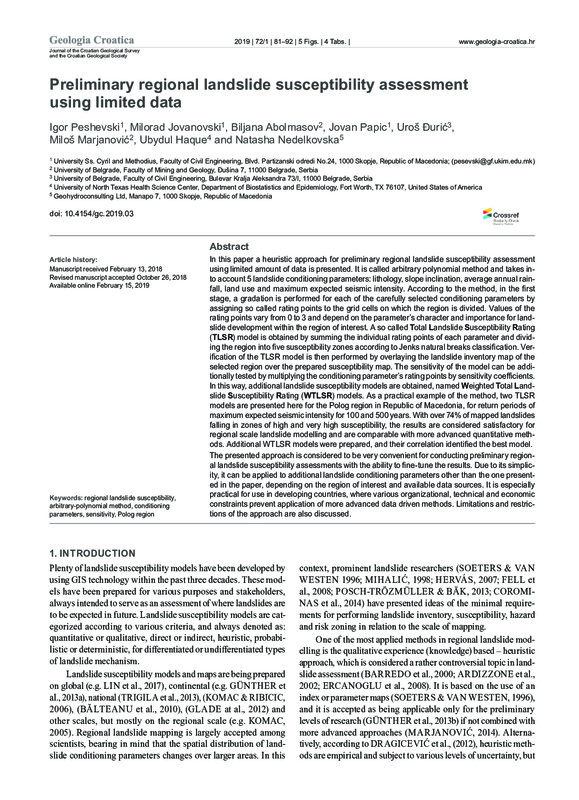Preliminary regional landslide susceptibility assessment using limited data
Објеката
- Тип
- Рад у часопису
- Верзија рада
- објављена верзија
- Језик
- енглески
- Креатор
- Igor Peshevski, Milorad Jovanovski, Biljana Abolmasov, Jovan Papic, Uroš Đurić, Miloš Marjanović, Ubydul Haque, Natasha Nedelkovska
- Извор
- Geologica Croatica
- Издавач
- Croatian Geological Society
- Датум издавања
- 2019
- Сажетак
-
In this paper a heuristic approach for preliminary regional landslide susceptibility assessment using limited amount of data is presented. It is called arbitrary polynomial method and takes into account 5 landslide conditioning parameters: lithology, slope inclination, average annual rainfall, land use and maximum expected seismic intensity. According to the method, in the first stage, a gradation is performed for each of the carefully selected conditioning parameters by assigning so called rating points to the grid cells on which the region is divided. Values of the rating points vary from 0 to 3 and depend on the parameter’s character and importance for landslide development within the region of interest. A so called Total Landslide Susceptibility Rating (TLSR) model is obtained by summing the individual rating points of each parameter and dividing
the region into five susceptibility zones according to Jenks natural breaks classification. Verification of the TLSR model is then performed by overlaying the landslide inventory map of the selected region over the prepared susceptibility map. The sensitivity of the model can be additionally tested by multiplying the conditioning parameter’s rating points by sensitivity coefficients. In this way, additional landslide susceptibility models are obtained, named Weighted Total Landslide Susceptibility Rating (WTLSR) models. As a practical example of the method, two TLSR models are presented here for the Polog region in Republic of Macedonia, for return periods of maximum expected seismic intensity for 100 and 500 years. With over 74% of mapped landslides falling in zones of high and very high susceptibility, the results are considered satisfactory for regional scale landslide modelling and are comparable with more advanced quantitative methods. Additional WTLSR models were prepared, and their correlation identified the best model. The presented approach is considered to be very convenient for conducting preliminary regional landslide susceptibility assessments with the ability to fine-tune the results. Due to its simplicity, it can be applied to additional landslide conditioning parameters other than the one presented in the paper, depending on the region of interest and available data sources. It is especially practical for use in developing countries, where various organizational, technical and economic constraints prevent application of more advanced data driven methods. Limitations and restrictions of the approach are also discussed. - том
- 1
- Број
- 72
- почетак странице
- 81
- крај странице
- 92
- doi
- 10.4154/gc.2019.03
- issn
- 1330-030
- Просторно покривање
- North Macedonia
- Subject
- klizišta, podložnost
- Шира категорија рада
- M20
- Ужа категорија рада
- М23
- Права
- Отворени приступ
- Лиценца
- Creative Commons – Attribution 4.0 International
- Формат
Igor Peshevski, Milorad Jovanovski, Biljana Abolmasov, Jovan Papic, Uroš Đurić, Miloš Marjanović, Ubydul Haque, Natasha Nedelkovska. "Preliminary regional landslide susceptibility assessment using limited data" in Geologica Croatica , Croatian Geological Society (2019). https://doi.org/10.4154/gc.2019.03 М23
This item was submitted on 18. новембар 2021. by [anonymous user] using the form “Рад у часопису” on the site “Радови”: http://drug.rgf.bg.ac.rs/s/repo
Click here to view the collected data.
